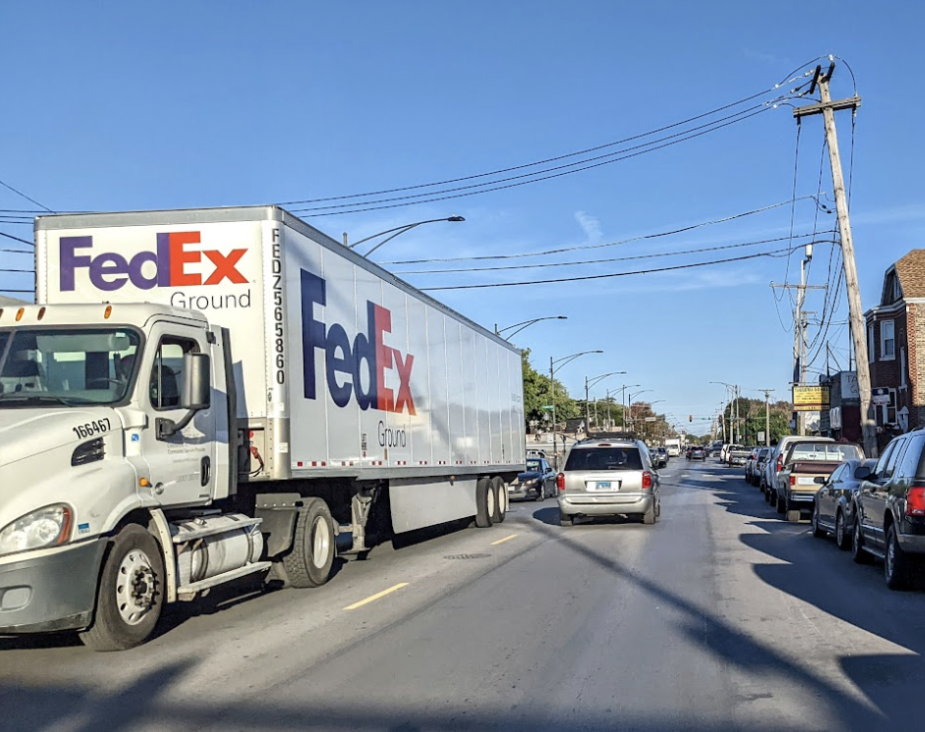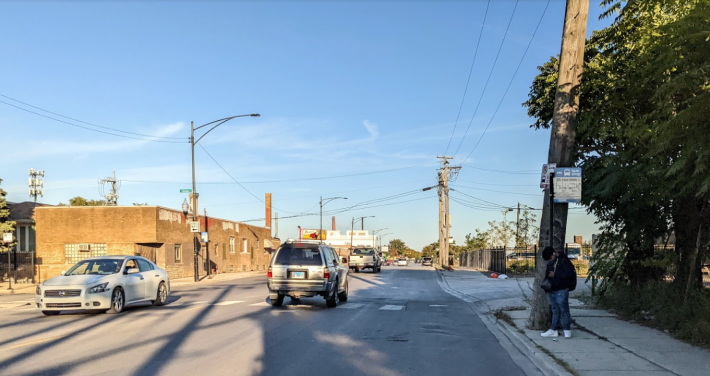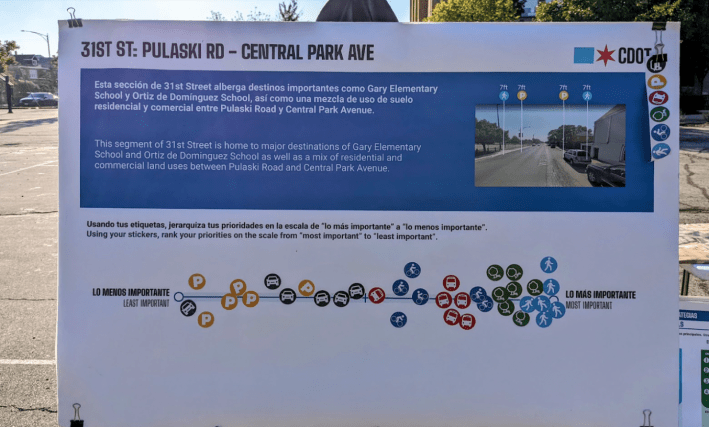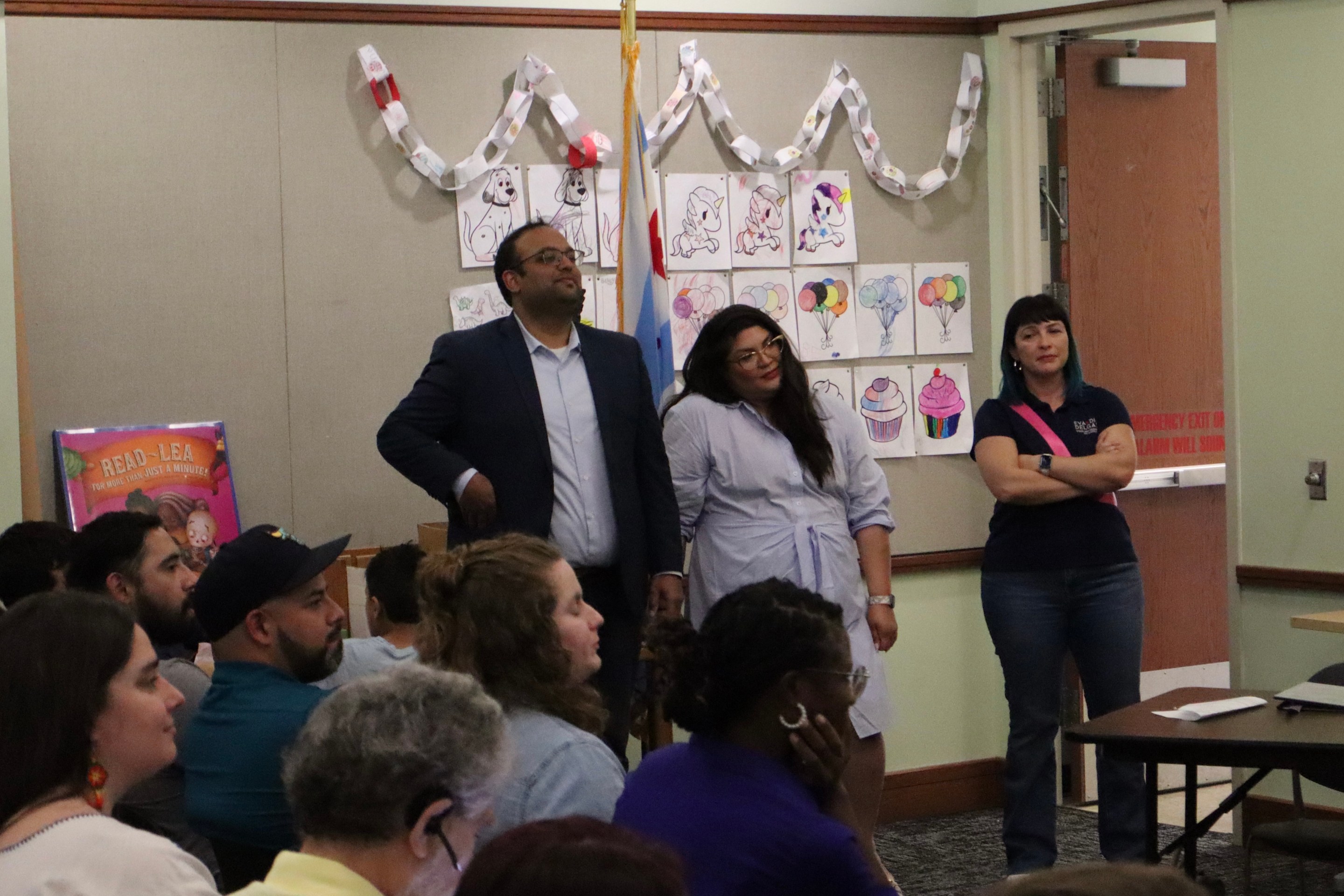How does Zero-Emission fit in the Southwest Industrial Corridor Modernization plan?
3:59 PM CDT on October 28, 2022

A heavy-duty truck going west on 31st Street. Photo: Ruth Rosas
Para leer este artículo en español, haga clic aquí.
The Southwest Side is no stranger to truck traffic. Distribution and warehouse facilities and industry, such as asphalt, oil, and gas, bring heavy diesel vehicles to neighborhood streets. If you’ve ever biked or walked through 31st Street, you have probably encountered the pungent smell of diesel exhaust.
This is an important transportation corridor in Little Village because 31st is one of the few streets that runs east-west across the neighborhood without rail interruptions. It is also an important corridor for community destinations. There are two elementary schools (Gary and Ortiz De Dominguez) and one high school (Little Village Lawndale), two parks, Piotrowski and La Villita Park, a variety of businesses including grocery stores, and industries such as an asphalt plant. 31st is also a major connection to the suburbs and I-55.
With the Southwest Industrial Corridor Modernization plan, the city has been trying to balance community-based goals with continued industry growth. The Chicago Department of Transportation hired consultants who launched the 31st Street Corridor Study. The study is looking at the corridor from Sacramento Boulevard to Cicero Avenue, the city limit. The website, which is both in English and Spanish, allows people to place pins on locations of importance on the map.
Over the past year CDOT, with its consultants, hosted community outreach events. Last week, they hosted two events to hear from the community, at Piotrowski Park at 32nd Street and Keeler Avenue and at Gary Elementary School on 31st Street between Hamlin and Lawndale avenues.
The outreach events included posters with information about the project and asking participants to envision the future of this important corridor. The posters ask about specific stretches of 31st: Pulaski Road (4000 W.) to Central Park Avenue (3600 W.) and Central Park to Kedzie Avenue (3200 W.) These two segments are where residents and industry overlap significantly. The posters ask attendees to name their priorities at intersections and along 31st, such as parking, bike lanes, pedestrian improvements, bus amenities, traffic concerns, and green space.

Although CDOT tweeted out information about the workshops in late September, it was hard to find info about the events on any city website. The Little Village Environmental Justice Organization posted them on their social media to get the word out. The advocacy group has been present at the outreach events. LVEJO’s senior transportation policy analyst José Acosta Córdova said the group’s main priority right now is dealing with the impacts of heavy duty trucks. Not only do these trucks pollute, but they also put pedestrians and cyclists at risk and put more wear-and-tear on roads than smaller vehicles.
31st is not very wide, although it would be possible to make space for bus-only lanes or protected bike lanes by converting curbside parking spaces. Acosta Córdova said that if the city was to pursue such a strategy, there would need to be careful consideration of how the parking conversions would impact community members.
Acosta Córdova explained why there is always so much traffic on 31st. The road is often congested with trucks, because I-55 is one of the busiest freight corridors in the country, and truckers are accessing distribution and warehouse facilities in the area. 31st is also just north of the Corwith Intermodal Facility, which he said [ is the “busiest rail yard within city limits, the third busiest in the region. So you have [millions] of containers that are coming through… It’s a very important corridor economically.”

LVEJO has carried out truck counts along 31st because there isn’t any specific information available through CDOT or the Illinois Department of Transportation. The group has worked with high school students from Little Village Lawndale High School’s AP Statistics class since 2017. The intersections they have focused on are 31st/Kostner Avenue (4400 W.), 31st/Pulaski Road, 31st/Kedzie Avenue, and 31st/California Avenue (2800 W.). Although they are not partnering with CDOT on this project, Acosta Córdova explained that they gave a list of priorities and key issues along the corridor to CDOT and they are keeping the public informed about any community outreach meetings.
Understanding that these freight facilities are not disappearing overnight is important. LVEJO has started to focus on how to mitigate the impacts of the facilities and freight activity. Recently, the group began co-leading a coalition along with the Respiratory Health Association, and Warehouse Workers for Justice called the Neighbors for an Equitable Transition to Zero-Emission (NET-Z). Many local and national organizations are heavily involved, including the Natural Resources Defense Council, Union of Concerned Scientists, and Environmental Defense Fund, along with the rest of the Chicago Environmental Justice network. Acosta Córdova explained that “the main focus is to get the governor to sign onto the Multi-State Medium- and Heavy-Duty Zero-Emission Vehicle Action Plan Memorandum of Understanding.”
17 other states and Washington D.C. have signed onto this memorandum calling for at least 30 percent of medium- and heavy-duty vehicle sales to be Zero-Emission Vehicles by 2030, with 100 percent compliance by 2050. One of the major goals of the memorandum is to reduce greenhouse gas emissions.
The coalition also plans to advocate for Illinois to adopt the Advanced Clean Truck rule, which requires manufacturers to develop cleaner vehicles and the NOx Omnibus rule that will reduce NOx (the nitrogen oxides that are most relevant for air pollution) and particulate matter emissions from medium- and heavy-duty vehicles.

In order to meet the GHG emission targets, we should focus on reducing vehicle dependence altogether. Electrification of vehicles alone will not solve climate change. However, the reality is zoning and racist policies have made us reliant on industries that pollute our streets with emissions from diesel medium- and heavy-duty trucks. In the short-term, CDOT could take an active role to help educate and inform residents on zero-emission vehicles and policies that help mitigate the problems caused by industry. Hopefully, the study will expand to do more education on these issues that have a growing impact on Black and brown communities.
For more information on the Neighbors for an Equitable Transition to Zero-Emission Coalition, contact José Acosta Córdova.
Stay in touch
Sign up for our free newsletter
More from Streetsblog Chicago
One agency to rule them all: Advocates are cautiously optimistic about proposed bill to combine the 4 Chicago area transit bureaus
The Active Transportation Alliance, Commuters Take Action, and Equiticity weigh in on the proposed legislation.
State legislators pushing to merge CTA, Pace, and Metra into one agency spoke at Transit Town Hall
State Sen. Ram Villivalam, (D-8th) and state Rep. Eva-Dina Delgado (D-3rd), as well as Graciela Guzmán, a Democratic senate nominee, addressed the crowd of transit advocates.



